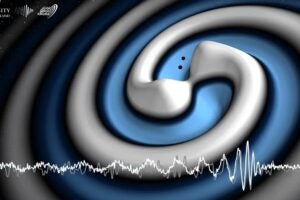AUSTIN, Texas — Using a new technology known as "quantum dots," engineers at The University of Texas at Austin have created a semiconductor laser that can compete with much more expensive lasers used for data transmission, but at the lower cost sought by the telecommunications industry to address growing internet traffic.
The quantum dot technology has allowed engineers at UT’s Microelectronics Research Center to use gallium arsenide, a chemical compound that is 10 times less expensive, to create the 1.3 micron laser wavelength in high demand by industry. Presently, commercial lasers that work at 1.3 microns are made from indium phosphide that is not only more expensive, but less heat tolerant.
"Because of the significant cost savings, the telecommunications industry has been pushing hard for a gallium arsenide laser that operates at this wavelength," said Dr. Dennis Deppe, associate professor of electrical and computer engineering. He and his research team of Dr. Diana Huffaker and three graduate students will announce the achievement Thursday (Sept. 10) at the La Jolla Advanced Topics Research School ’98, Semiconductor Science and Technology Conference in La Jolla, Calif.
The 1.3 micron wavelength is important because it allows optical fibers in telephone lines to transmit much more information over long distances and maintains truer sound and images in high speed data applications such as the internet.
Using quantum dots to create the lasers is a relatively new approach. Also known as "artificial atoms" because they have an electronic structure similar to natural atoms, the quantum dots are tiny clusters of semiconductor material that trap electrical charges. As the trapped charges lose their energy, they emit light, which can be used in high speed lasers.
Deppe and Huffaker found that by engineering the quantum dots, which are 20,000 times smaller than the diameter of a human hair, they could increase the laser wavelengths of gallium arsenide to record levels.
Incorporating the same technology last year, Deppe’s group collaborated with Dr. Joe Campbell, a UT professor of electrical engineering, to use quantum dots to create the detector for this type of laser.
"To bring fiber interconnects to businesses, homes and computers, we needed inexpensive, gallium arsenide lasers that until recently did not exist at this wavelength, and until now did not perform well," said Deppe. "With both the laser emitter and detector demonstrated in the laboratory, the technology can become a reality. An especially important application to obtain low cost will be the Vertical Cavity Surface Emitting Laser, or VCSEL, a device that is very difficult to make using indium phosphide technology."
Bar code scanners, digital video discs and read/write CDs also use VCSELs. Because of the longer wavelength, a variation of the quantum dot laser technology can also become important when future computer chips use light instead of wires to transmit information from chip-to-chip, noted Deppe.
"This is a major technical advance," said Dr. Jack Jewell, formerly a distinguished member of the technical staff at Bell Labs and now chief technical officer of Picolight, an aggressive startup supplier to the data communications industry which wants to develop a gallium arsenide laser. "Dr. Deppe’s work opens the path for commercialization and can trigger a large increase in industrial research and development of this technology."
Jewell estimates the laser is at least two years from commercialization.
Deppe’s work is funded by the National Science Foundation and the state of Texas Advanced Research Program.



